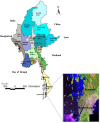Spatial distribution, work patterns, and perception towards malaria interventions among temporary mobile/migrant workers in artemisinin resistance containment zone
- PMID: 24884534
- PMCID: PMC4032392
- DOI: 10.1186/1471-2458-14-463
Spatial distribution, work patterns, and perception towards malaria interventions among temporary mobile/migrant workers in artemisinin resistance containment zone
Abstract
Background: Mobile populations are at a high risk of malaria infection and suspected to carry and spread resistant parasites. The Myanmar National Malaria Control Programme focuses on preventive interventions and vector control measures for the temporary mobile/migrant workers in Myanmar Artemisinin Resistance Containment Zones.
Methods: A prospective cross-sectional study was conducted in 2012 in Kawthaung and Bokepyin townships of Tanintharyi Region, Myanmar, covering 192 mobile/migrant aggregates. The objectives were to identify the spatial distribution of the mobile/migrant populations, and to assess knowledge, attitudes, perceptions, and practices concerning malaria prevention and control, and their preferred methods of interventions. The structure of the 192 migrant aggregates was investigated using a migrant mapping tool. Individual and household information was collected by structured interviews of 408 respondents from 39 aggregates, supplemented by 12 in-depth interviews of health care providers, authorities, volunteers, and employers. Data were analyzed by triangulating quantitative and qualitative data.
Results: The primary reasons for the limitation in access to formal health services for suspected malaria within 24 hours were identified to be scattered distribution of migrant aggregates, variable working hours and the lack of transportation. Only 19.6% of respondents reported working at night from dusk to dawn. Among study populations, 73% reported a perceived risk of contracting malaria and 60% reported to know how to confirm a suspected case of malaria. Moreover, only 15% was able to cite correct antimalarial drugs, and less than 10% believed that non-compliance with antimalarial treatment may be related to the risk of drug resistance. About 50% of study population reported to seeking health care from the public sector, and to sleep under ITNs/LLINs the night before the survey. There was a gap in willingness to buy ITNs/LLINs and affordability (88.5% vs. 60.2%) which may affect their sustained and consistent use. Only 32.4% across all aggregates realized the importance of community participation in effective malaria prevention and control.
Conclusions: Community-based innovative approaches through strong collaboration and coordination of multi-stakeholders are desirable for relaying information on ITNs/LLINs, rapid diagnostic test, and artemisinin combination therapy and drug resistance successfully across the social and economic diversity of mobile/migrant aggregates in Myanmar.
Figures



Similar articles
-
Multisectoral Approach to Support Use of Insecticide-Treated Net for Malaria Prevention Among Mobile and Migrant Populations in Myanmar: A Systematic Review.J Infect Dis. 2020 Oct 29;222(Suppl 8):S717-S725. doi: 10.1093/infdis/jiaa335. J Infect Dis. 2020. PMID: 33119095 Free PMC article.
-
Mobility dynamics of migrant workers and their socio-behavioral parameters related to malaria in Tier II, Artemisinin Resistance Containment Zone, Myanmar.BMC Public Health. 2015 Sep 14;15:886. doi: 10.1186/s12889-015-2241-0. BMC Public Health. 2015. PMID: 26370297 Free PMC article.
-
Assessment of household ownership of bed nets in areas with and without artemisinin resistance containment measures in Myanmar.Infect Dis Poverty. 2018 Mar 23;7(1):19. doi: 10.1186/s40249-018-0399-2. Infect Dis Poverty. 2018. PMID: 29571301 Free PMC article.
-
Barriers in distribution, ownership and utilization of insecticide-treated mosquito nets among migrant population in Myanmar, 2016: a mixed methods study.Malar J. 2019 May 14;18(1):172. doi: 10.1186/s12936-019-2800-4. Malar J. 2019. PMID: 31088451 Free PMC article.
-
Inter-sectoral approaches for the prevention and control of malaria among the mobile and migrant populations: a scoping review.Malar J. 2018 Nov 16;17(1):430. doi: 10.1186/s12936-018-2562-4. Malar J. 2018. PMID: 30445959 Free PMC article.
Cited by
-
Effectiveness of repellent delivered through village health volunteers on malaria incidence in villages in South-East Myanmar: a stepped-wedge cluster-randomised controlled trial protocol.BMC Infect Dis. 2018 Dec 14;18(1):663. doi: 10.1186/s12879-018-3566-y. BMC Infect Dis. 2018. PMID: 30547749 Free PMC article. Clinical Trial.
-
Multisectoral Approach to Support Use of Insecticide-Treated Net for Malaria Prevention Among Mobile and Migrant Populations in Myanmar: A Systematic Review.J Infect Dis. 2020 Oct 29;222(Suppl 8):S717-S725. doi: 10.1093/infdis/jiaa335. J Infect Dis. 2020. PMID: 33119095 Free PMC article.
-
Understanding psychosocial determinants of malaria behaviours in low-transmission settings: a scoping review.Malar J. 2024 Jan 10;23(1):15. doi: 10.1186/s12936-023-04831-9. Malar J. 2024. PMID: 38200574 Free PMC article.
-
Human mobility and the infectious disease transmission: A systematic review.Geo Spat Inf Sci. 2024;27(6):1824-1851. doi: 10.1080/10095020.2023.2275619. Epub 2023 Nov 29. Geo Spat Inf Sci. 2024. PMID: 40046953 Free PMC article.
-
Low uptake of preventive interventions among malaria cases in Swaziland: towards malaria elimination.Public Health Action. 2018 Apr 25;8(Suppl 1):S29-S33. doi: 10.5588/pha.17.0016. Public Health Action. 2018. PMID: 29713591 Free PMC article.
References
-
- WHO. Myanmar Artemisinin Resistance Containment Surveys. Draft Report. Myanmar: World Health Organization, Country Office; 2012.
-
- MOH. Health in Myanmar, 2012. NayPyiTaw: Ministry of Health; 2013.
-
- Cui L, Yan G, Sattabongkot J, Cao Y, Chen B, Chen X, Fan Q, Fang Q, Jongwutiwes S, Parker D, Sirichaisinthop J, Kyaw MP, Su XZ, Yang H, Yang Z, Wang B, Xu J, Zheng B, Zhong D, Zhou G. Malaria in the Greater Mekong Subregion: Heterogeneity and complexity. Acta Trop. 2012;121(3):227–239. doi: 10.1016/j.actatropica.2011.02.016. - DOI - PMC - PubMed
-
- Kyaw MP, Nyunt MH, Chit K, Aye MM, Aye KH, Aye MM, Lindegardh N, Tarning J, Imwong M, Jacob CG, Rasmussen C, Perin J, Ringwald P, Nyunt MM. Reduced susceptibility of Plasmodium falciparum to Artesunate in Southern Myanmar. PLoS One. 2013;8(3):e57689. doi: 10.1371/journal.pone.0057689. - DOI - PMC - PubMed
-
- Khamsiriwatchara A, Wangroongsarb P, Thwing J, Eliades J, Satimai W, Delacollette C, Kaewkungwal J. Respondent-driven sampling on the Thailand-Cambodia border. 1. Can malaria cases be contained in mobile migrant workers? Malar J. 2011;10:120. doi: 10.1186/1475-2875-10-120. http://www.malariajournal.com. - DOI - PMC - PubMed
MeSH terms
Substances
LinkOut - more resources
Full Text Sources
Other Literature Sources
Medical
Miscellaneous

